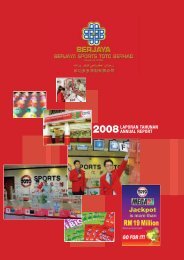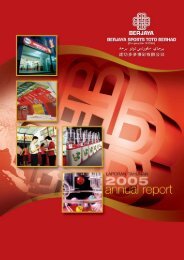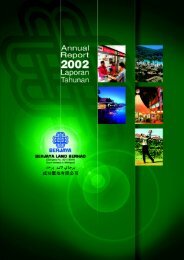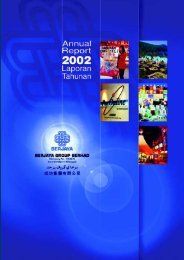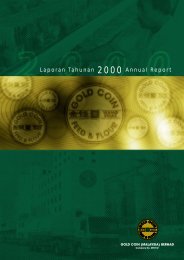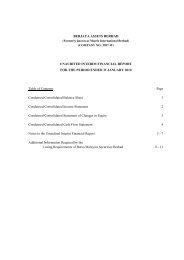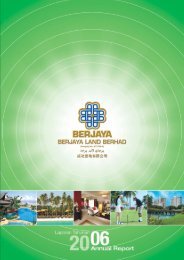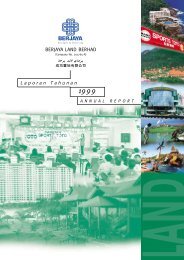Pg 147 - Berjaya Corporation Berhad
Pg 147 - Berjaya Corporation Berhad
Pg 147 - Berjaya Corporation Berhad
Create successful ePaper yourself
Turn your PDF publications into a flip-book with our unique Google optimized e-Paper software.
<strong>Berjaya</strong> Land <strong>Berhad</strong> (201765-A)<br />
Annual Report 2005<br />
53<br />
2 SIGNIFICANT ACCOUNTING POLICIES (CONT’D)<br />
(m) Foreign Currencies (Cont’d)<br />
Assets (including goodwill) and liabilities and trading results of foreign subsidiaries are translated into Ringgit Malaysia at the<br />
approximate rates of exchange ruling at the balance sheet date except for share capital which is included at historical rate. All<br />
exchange differences on translation are taken directly to an exchange reserve account.<br />
The principal closing rates used in translation are as follows:<br />
30 April 2005 30 April 2004<br />
Foreign currency RM RM<br />
1 United States Dollar 3.800 3.800<br />
1 Singapore Dollar 2.307 2.229<br />
1 Fijian Dollar 2.275 2.150<br />
1 Australian Dollar 2.962 2.732<br />
1 Sterling Pound 7.256 6.732<br />
1 Mauritius Rupee 0.131 0.141<br />
1 Sri Lanka Rupee 0.038 0.039<br />
1 Seychelles Rupee 0.733 0.725<br />
1 Hong Kong Dollar 0.487 0.487<br />
1 Philippine Peso 0.070 0.068<br />
1 Indian Rupee 0.087 0.086<br />
(n) Provisions for Liabilities<br />
Provisions for liabilities are recognised when the Group has a present obligation as a result of a past event and it is probable that<br />
an outflow of resources embodying economic benefits will be required to settle the obligations, and a reliable estimate of the amount<br />
can be made. Provisions are reviewed at each balance sheet date and adjusted to reflect the current best estimate. Where the<br />
effect of the time value of money is material, the amount of provision is the present value of the expenditure expected to be required<br />
to settle the obligation.<br />
(o) Impairment of Assets<br />
At each balance sheet date, the Group reviews the carrying amounts of its assets other than inventories, receivables, other<br />
non-current investments and marketable securities, to determine whether there is any indication of impairment. If any such<br />
indication exists, impairment is measured by comparing the carrying values of the assets with their recoverable amounts.<br />
Recoverable amount is the higher of net selling price and value in use, which is measured by reference to discounted future cash<br />
flows.<br />
An impairment loss is recognised as an expense in the income statement immediately. Reversal of impairment losses recognised<br />
in prior years is recorded when the impairment losses recognised for the asset have decreased.<br />
(p) Financial Instruments<br />
Financial instruments are recognised in the balance sheet when the Group has become a party to the contractual provisions of the<br />
instrument.<br />
(i)<br />
Other Non-Current Investments<br />
Non-current investments comprise quoted and unquoted securities, bonds and warrants but exclude investments in subsidiary<br />
and associated companies.<br />
Other non-current investments are stated at cost less accumulated impairment losses. Such impairment is made when there<br />
is a decline, other than temporary, in value of investments and it is recognised as an expense in the period in which the decline<br />
occurred.<br />
(ii)<br />
Receivables<br />
Trade and other receivables are carried at anticipated realisable value. All known bad debts are written off while doubtful debts<br />
are provided for based on estimates of possible losses that may arise from non-collection.



